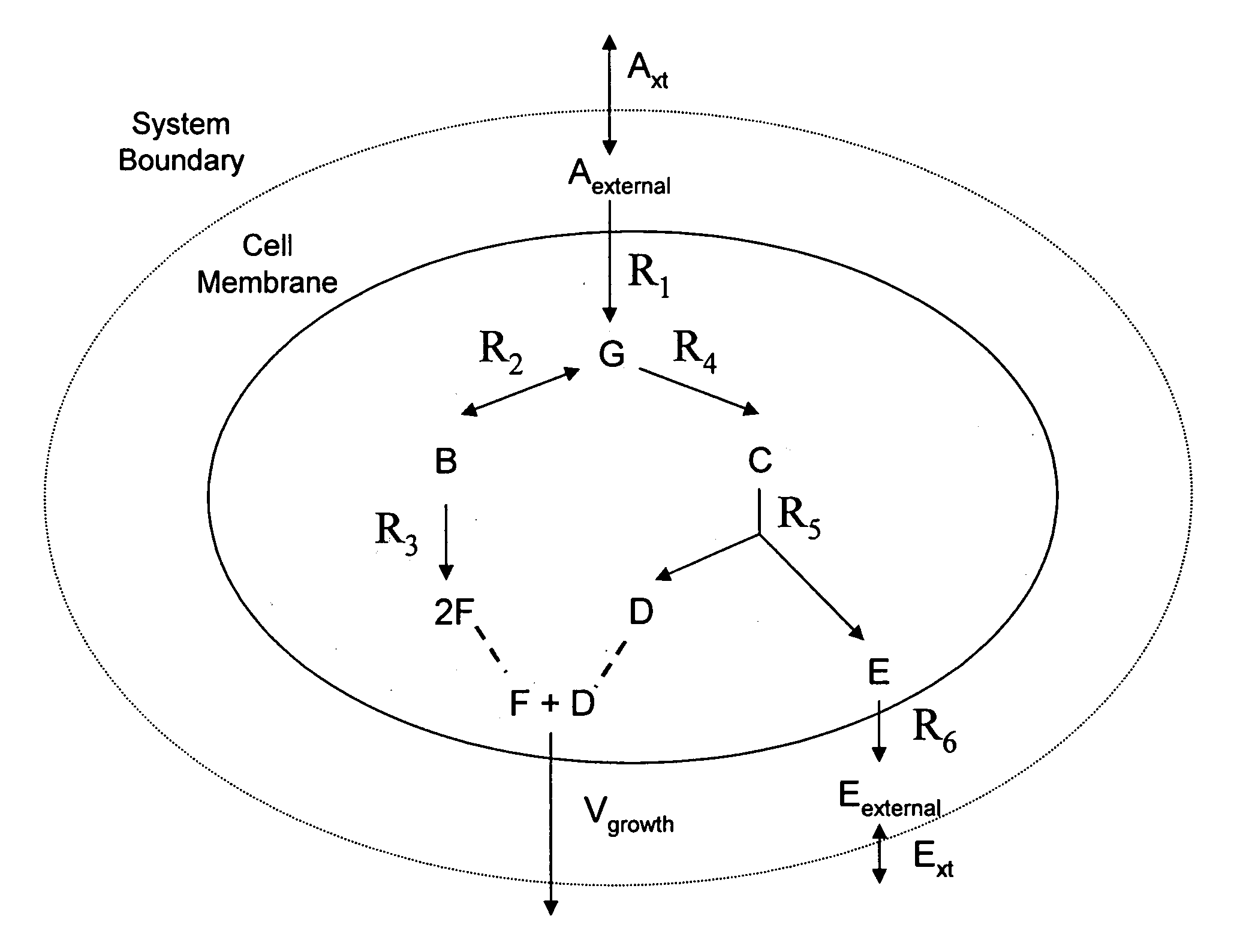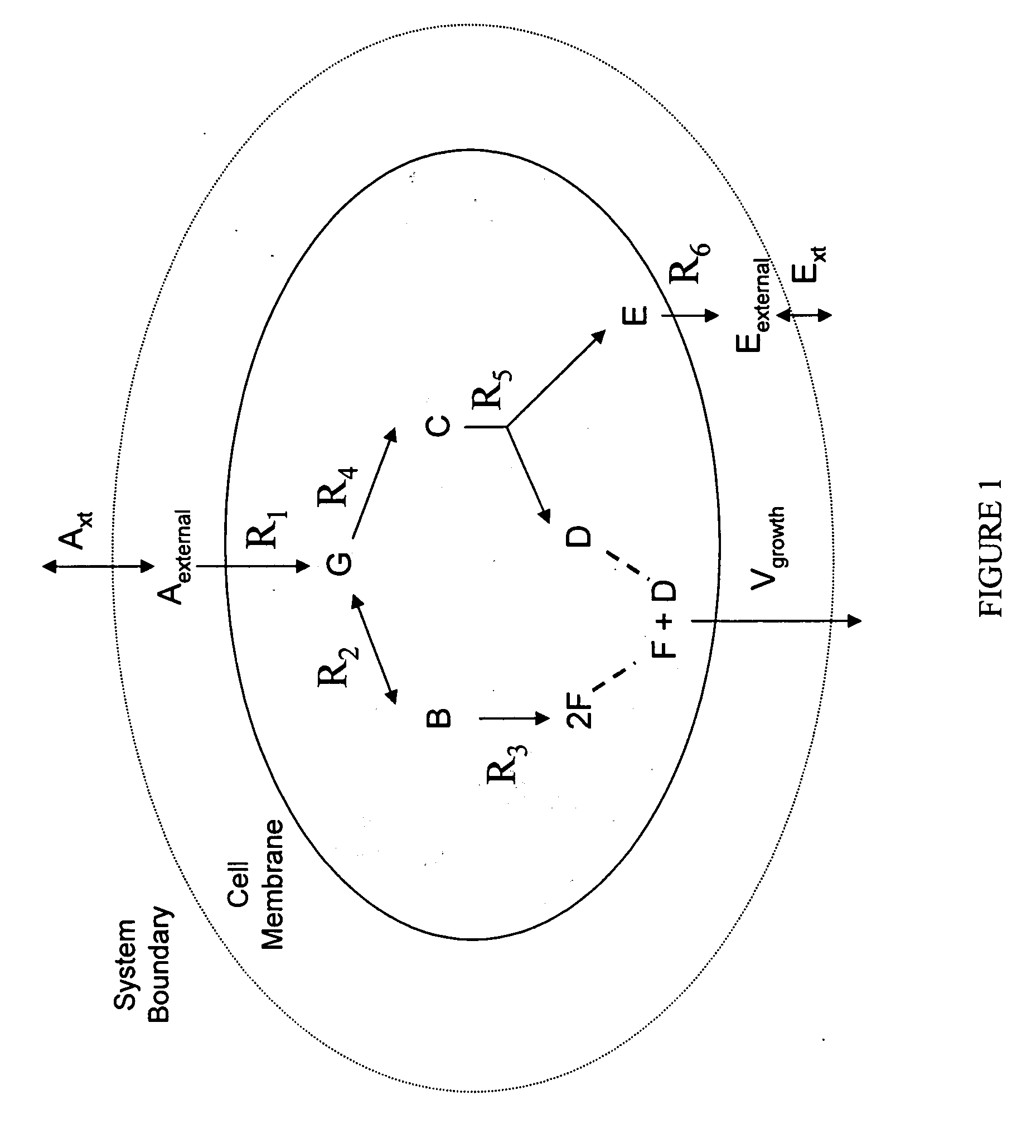Multicellular metabolic models and methods
a multi-cellular metabolic model and metabolic model technology, applied in the field of chemical reaction network analysis, can solve the problems of unreliable unreliable results, and inability to take into account the approach to drug and nutraceutical developmen
- Summary
- Abstract
- Description
- Claims
- Application Information
AI Technical Summary
Problems solved by technology
Method used
Image
Examples
example i
[0146] This example shows the construction of a universal Homo sapiens metabolic reaction database, a Homo sapiens core metabolic reaction database and a Homo sapiens muscle cell metabolic reaction database. This example also shows the iterative model building process used to generate a Homo sapiens core metabolic model and a Homo sapiens muscle cell metabolic model.
[0147] A universal Homo sapiens reaction database was prepared from the genome databases and biochemical literature. The reaction database shown in Table 1 contains the following information: [0148] Locus ID—the locus number of the gene found in the LocusLink website. [0149] Gene Ab.—various abbreviations which are used for the gene. [0150] Reaction Stoichiometry—includes all metabolites and direction of the reaction, as well as reversibility. [0151] E.C.—The Enzyme Commission number.
[0152] Additional information included in the universal reaction database, although not shown in Table 1, included the chapter of Salway,...
example ii
[0159] This example shows how human metabolism can be accurately simulated using a Homo sapiens core metabolic model.
[0160] The human core metabolic reaction database shown in Table 3 was used in simulations of human core metabolism. This reaction database contains a total of 65 reactions, covering the classic biochemical pathways of glycolysis, the pentose phosphate pathway, the tricitric acid cycle, oxidative phosphorylation, glycogen storage, the malate / aspartate shuttle, the glycerol phosphate shuttle, and plasma and mitochondrial membrane transporters. The reaction network was divided into three compartments: the cytosol, mitochondria, and the extracellular space. The total number of metabolites in the network is 50, of which 35 also appear in the mitochondria. This core metabolic network accounts for 250 human genes.
[0161] To perform simulations using the core metabolic network, network properties such as the P / O ratio were specified using Salway, supra (1999) as a reference...
example iii
[0164] This example shows how human muscle cell metabolism can be accurately simulated under various physiological and pathological conditions using a Homo sapiens muscle cell metabolic model.
[0165] As described in Example I, the core metabolic model was extended to also include all the major reactions occurring in the skeletal muscle cell, adding new functions to the classical metabolic pathways found in the core model, such as fatty acid synthesis and β-oxidation, triacylglycerol and phospholipid formation, and amino acid metabolism. Simulations were performed using the muscle cell reaction database shown in Table 4. The biochemical reactions were again compartmentalized into cytosolic and mitochondrial compartments.
[0166] To simulate physiological behavior of human skeletal muscle cells, an objective function had to be defined. Growth of muscle cells occurs in time scales of several hours to days. The time scale of interest in the simulation, however, was in the order of severa...
PUM
| Property | Measurement | Unit |
|---|---|---|
| data structure | aaaaa | aaaaa |
| data structures | aaaaa | aaaaa |
| mass balance | aaaaa | aaaaa |
Abstract
Description
Claims
Application Information
 Login to View More
Login to View More - R&D
- Intellectual Property
- Life Sciences
- Materials
- Tech Scout
- Unparalleled Data Quality
- Higher Quality Content
- 60% Fewer Hallucinations
Browse by: Latest US Patents, China's latest patents, Technical Efficacy Thesaurus, Application Domain, Technology Topic, Popular Technical Reports.
© 2025 PatSnap. All rights reserved.Legal|Privacy policy|Modern Slavery Act Transparency Statement|Sitemap|About US| Contact US: help@patsnap.com



